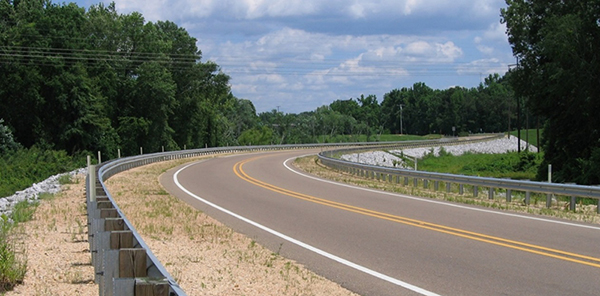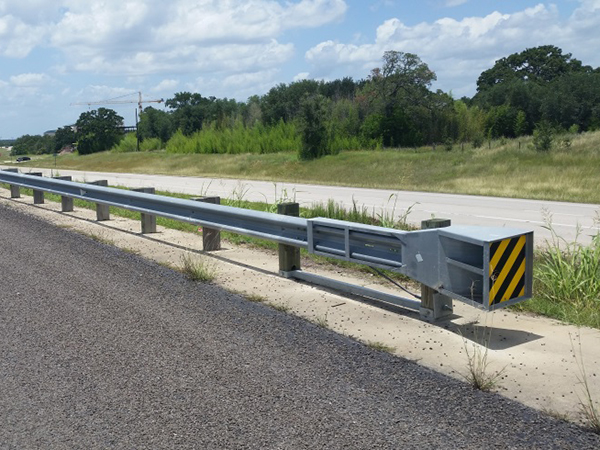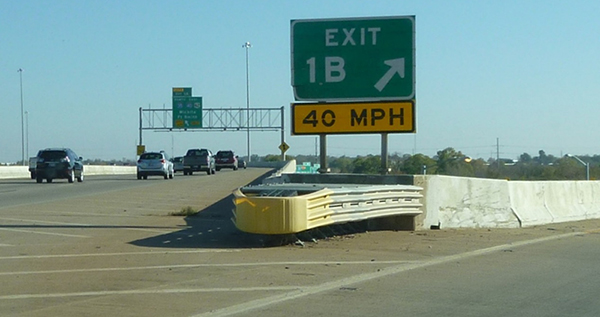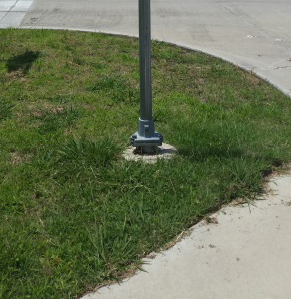Chapter 1. Background
Section 1429 of the FAST Act requires the Secretary of Transportation to study ID methods that transportation agencies can use to collect data about their roadside highway safety hardware. Transportation agencies can use these ID methods to evaluate the in-service performance of the roadside safety hardware and improve the data collected about the hardware. Section 1429 states the following:
SEC. 1429. IDENTIFICATION OF ROADSIDE HIGHWAY SAFETY HARDWARE DEVICES.
(a) STUDY.–The Secretary shall conduct a study on methods for identifying roadside highway safety hardware devices to improve the data collected on the devices, as necessary for in-service evaluation of the devices.
(b) CONTENTS.–In conducting the study under subsection (a), the Secretary shall evaluate identification methods based on the ability of the method–
(1) to convey information on the devices, including manufacturing date, factory of origin, product brand, and model;
(2) to withstand roadside conditions; and
(3) to connect to State and regional inventories of similar devices.
(c) IDENTIFICATION METHODS.–The identification methods to be studied under this section include stamped serial numbers, radio-frequency identification, and such other methods as the Secretary determines appropriate.
(d) REPORT TO CONGRESS.–Not later than January 1, 2018, the Secretary shall submit to Congress a report on the results of the study under subsection (a).
This study is designed to satisfy the Section 1429 requirement. The study included a literature review, a review of the practices of transportation agencies and other industries, and input from an expert panel. The roadside safety hardware expert panel included manufacturers, installers, researchers from across the United States, and staff members from three State departments of transportation. The practitioners considered parameters that agencies could use to effectively select ID methods and improve their capability to implement ISPE or asset management programs.
This first chapter gives a brief background of roadside safety hardware, potential opportunities arising from identifying and documenting this hardware, and gaps in current methods of identifying and documenting information about roadside safety hardware.
Roadside Safety Hardware
Roadside safety hardware is part of the highway infrastructure that functions to reduce crash severity. Roadway departures accounted for over half of the 35,092 traffic fatalities in the United States in 2015.(3) Roadside design provides for a clear, recoverable area where feasible, and where roadsides cannot be designed free of fixed objects, crashworthy roadside safety hardware is used to reduce risk. Despite improved design and crash testing of hardware, approximately 3 percent of U.S. traffic fatalities occur in vehicles where the most harmful event involved the hardware itself.*
Roadside Safety Hardware Definitions
The AASHTO Roadside Design Guide provides information on designing roadways to reduce crash risk and severity. Roadside barriers are designed to contain and redirect vehicles. Barriers are installed only in locations where there is potential for greater harm, such as crossing into oncoming traffic, rolling over on a steep slope, or hitting trees. When roadside assets are necessary, such as signs and luminaires, supports have safety design features to break away in a crash so that they pose minimal risk to motorists.
Before discussing and evaluating ID methods, it is important to understand the different types of roadside safety hardware and their functions. This section defines the following common hardware and gives some examples:
- Longitudinal barriers (guardrails).
- Barrier terminals (guardrail end treatments).
- Crash cushions.
- Breakaway hardware (signs, luminaires, etc.).
Longitudinal Barriers
The AASHTO Roadside Design Guide defines a barrier as:
A device which provides a physical limitation through which a vehicle would not normally pass. It is intended to contain or redirect an errant vehicle.(1)
The term barrier in this report includes:
- Roadside barrier–"A longitudinal barrier used to shield roadside obstacles or non-traversable terrain features."
- Median barrier–"A longitudinal barrier used to prevent an errant vehicle from crossing the highway median."
- Bridge railing–"A longitudinal barrier whose primary function is to prevent an errant vehicle from going over the side of the bridge structure."(1)
Figure 1 shows an example of longitudinal barrier.

Figure 1. Photo. Example of longitudinal barrier.
Barrier Terminals
The AASHTO Roadside Design Guide defines a terminal as:
…a crashworthy anchorage, a device used to anchor a flexible or semi-rigid barrier to the ground. Being crashworthy, terminals are normally used at the end of a barrier that is located within the clear zone or that is likely to be impacted by errant vehicles.(1)
Figure 2 shows an example of a barrier terminal.

Figure 2. Photo. Example of a barrier terminal.
Crash Cushions
The AASHTO Roadside Design Guide defines crash cushions, also known as impact attenuators, as:
…typically attached to or placed in front of concrete barriers (median barriers, roadside barriers, or bridge railings) or other rigid fixed objects, such as bridge piers, to prevent an errant vehicle from impacting fixed objects by gradually decelerating the vehicle to a safe stop or by redirecting the vehicle away from the obstacle.(1)
Figure 3 shows an example of a crash cushion.

Figure 3. Photo. Example of a crash cushion.
Breakaway Hardware
The AASHTO Roadside Design Guide defines the term breakaway as:
A design feature which allows a device such as a sign, luminaire, or traffic signal support to yield or separate upon impact. The release mechanism may be a slip plane, plastic hinges, fracture elements, or a combination of these.(1)
Breakaway hardware for this report includes supports for signs, luminaires, and traffic signals. Figure 4 shows an example of breakaway hardware, specifically a sign support.

Figure 4. Photo. Example of breakaway hardware.
Safety Hardware Performance
Crash testing of safety hardware is a vital first step in understanding how hardware will perform. However, crash testing is performed under ideal conditions, which are not always representative of every real-world condition across the entire roadway network. And while crash-testing parameters are set to test the limits of performance of hardware, some crashes may occur at higher speeds, different angles, or different vehicle parameters than the crash tests. The ISPE, continuous monitoring, and asset management allow agencies to gather more data about how safety hardware performs in practice.
In-Service Performance Evaluation
The AASHTO Roadside Design Guide states:
…in-service evaluation is a very important step when assessing the impact performance of a new or extensively modified safety feature [or hardware]. The purpose of in-service evaluation is to determine and document the manner in which the safety feature [or hardware] performs within a broad range of collisions and real-world conditions, such as environmental, operational, and maintenance situations for typical site and traffic conditions.
The Roadside Design Guide lists the following factors that can cause differences between field performance and crash test results:
- Field impact conditions that are not included in crash test guidelines, such as non-tracking and side impacts.
- Site conditions, such as roadside slopes and ditches, that adversely affect vehicle kinematics before, during, or after impact with the safety device.
- Sensitivity to installation details, such as soil resistance or barrier flare configuration.(1)
The ISPEs allow transportation agencies to identify overall performance, potential weaknesses, and design problems of roadside safety hardware. The FHWA and AASHTO encourage agencies to evaluate in-service hardware and continuously monitor it to assess its field performance. However, agencies themselves determine how they monitor and assess in-field performance.
ISPEs may include the following elements:
- An installation and maintenance checklist–evaluate items related to construction, installation, and maintenance of the hardware.
- Inventory–examine the location and design details of the installation.
- Crash monitoring–examine the reported and non-reported crashes involving the installation.
- In-depth investigation–investigate the crashes that resulted in serious injury or a fatality by obtaining the police crash report, documenting the site, examining the involved vehicle, and making efforts to reconstruct the crash.
Continuous Monitoring
Even after the hardware has undergone a successful ISPE, the AASHTO Manual for Assessing Safety Hardware strongly recommends continuous monitoring. Continuous monitoring requires examining highway and traffic data, maintenance records, roadside feature inventory data, crash data, and other components for periodic analysis.(4)
Asset Management
Existing asset management practices used by transportation agencies may be an efficient means of accomplishing ISPE. Section 101(a)(2) of Title 23 of the United States Code defines asset management as:
…a strategic and systematic process of operating, maintaining, and improving physical assets, with a focus on both engineering and economic analysis based upon quality information, to identify a structured sequence of maintenance, preservation, repair, rehabilitation, and replacement actions that will achieve and sustain a desired state of good repair over the lifecycle of the assets at minimum practicable cost.(2)
The objective of asset management is to make decisions based on quality information and focused on engineering and business practices for resource allocation and utilization.(5)
Current requirements in asset management are for transportation agencies to develop asset management plans for pavement and bridges. However, expanding asset management to safety assets is an opportunity to obtain quality data for analysis in an ISPE program.
Data Collection
Quality data are key components of asset management and analyses such as ISPEs. The industry generally divides data collection techniques for asset management into three categories:
- Manual data collection.
- Automated collection.
- Remote collection.
Currently, these are the state-of-the-practice techniques for collecting information about roadway assets, including roadside safety hardware.
Manual Collection
Manual collection may use handheld computers, global positioning system (GPS) units, or pen-and-paper records. Data collectors may stop at a particular location and survey the condition and location of each asset, or they may conduct a driving survey.(6) The means of recording data may depend on the level of detail desired by the agency.
Automated Collection
Automated collection involves a vehicle equipped with technologies to identify and document transportation assets. The vehicle may be equipped with video cameras, a GPS unit, laser imaging detection and ranging (LIDaR), and computer hardware to capture, store, and process collected data.(6)
Remote Collection
Remote collection uses photo logs, video logs, and satellite images. With remote collection, the images are used in conjunction with ground information to describe the location, condition, attributes, and characteristics of the roadway asset.(6) The quality of the remote data collection may be dependent on existing records about the asset.
POTENTIAL OPPORTUNITIES
Identifying and documenting safety hardware can facilitate ISPE. As discussed previously, there are various methods to collect this information, including using barcodes, RFID, and serial numbers. For true facilitation of ISPE, transportation agencies must evaluate suitable ID methods that provide:
- Unique safety hardware tracking.
- Inception-to-salvage tracking.
- Robust data sets for analysis.
- Connectivity and real-time information.
This report provides information on determining how the three ID methods (barcodes, RFID, and serial numbers) might improve a transportation agency's capability to identify and document safety hardware.
Unique Safety Hardware Tracking
Traditional asset management practices typically look at the transportation system as a whole–tracking system conditions, needs, and performance; developing costs for maintaining and preserving existing assets; and determining when to undertake an action on an asset.(5) For safety hardware, an asset management system needs to be able to provide specific, unique information about the hardware. This information could describe the hardware (as a system), installed components, the manufacturer, the installer, or the location.
This information can be analyzed over time by many characteristics and can help transportation agencies develop performance profiles, which aid in decision making. The additional cost of these capabilities and the complexity of the databases and analysis procedures needed to use them must be considered as well. Methods need to match the capabilities and available funds of the agencies that would potentially use them.
Inception-to-Salvage Tracking
Another consideration is the capability to follow roadside safety hardware and components from their origination at a manufacturer's factory to their final disposition in a crash, system upgrade, or other reason for replacement. The concept and value of event-based tracking were heavily considered during this study, including the following:
- Manufacturer information could be useful to determine where specific safety hardware components are located if ISPEs found a problem with components manufactured during a certain time frame.
- Installer information could be used to determine where additional training is needed to improve installation practices of certain types of safety hardware and whether the training should be aimed at State, local, or contract personnel.
- General maintenance information, such as repairs needed following winter plowing, could be useful to track the durability and life-cycle costs of various safety hardware and may be useful to determine training needs.
- Post-crash maintenance information about repairing or replacing components or the safety hardware (as a system) could be used for the same purposes as general maintenance information. Post-crash maintenance information could also make the repair process more efficient.
- Removal information may be useful for agencies. Information could also include the new safety hardware or configuration used, and whether other work was completed that removed the need for the hardware.
Robust Data Sets
Another aspect considered in the evaluation of ID methods is the ability of an ID method to support robust data sets for use with ISPE and asset management analysis. Robust data may allow researchers to analyze safety hardware to determine which performs better under different roadside and crash conditions. The data could also speed up the ISPE process and provide more accurate data about installation and maintenance of safety hardware.
Connectivity and Real-Time Information
With the many cloud-based connectivity options available, the ability of an ID method to provide near-real-time safety hardware information is another important consideration in the evaluation. Having information that can be accessed remotely and updated actively reduces labor, provides better quality information to associate with crash data, and may result in more timely analysis.
GAPS IN CURRENT PRACTICES
Gaps in the current processes used by transportation agencies to identify and document roadside safety hardware include the following:
- Current practices for roadway asset management document only location, usually on a regular inventory schedule (annual, every 5 years, etc.). Collecting this data is a significant undertaking, which is evident in the continued rise in transportation agencies using service providers to gather data through mobile means (such as vans equipped with LIDaR and navigational sensors). There were very few uses of asset management identified that include roadside hardware.
- Transportation agencies and service providers are not readily able to collect and/or record specific data about roadside safety hardware (i.e., installation date, installer, and number of repairs). If transportation agencies had a record of this information, they might be able to successfully integrate it into an ISPE or safety asset management program but might have difficulty keeping the database current.
- The accuracy and availability of such records may be heavily dependent on hardcopy documentation kept by various departments and would require additional information requests from manufacturers and installers. Transportation agencies, manufacturers, installers, and maintenance personnel may also lack a common data set.
- Access to these types of data is usually limited to the transportation agency, if not a specific division of the transportation agency. There are no documented examples of interorganizational electronic data sharing, such as installer to transportation agency.
This report addresses these gaps by investigating ID methods with the potential to improve data collection and storage necessary for ISPE.
HOW THIS REPORT IS ORGANIZED
This report summarizes findings in the following chapters:
- Chapter 2: Current Safety Hardware ID Practices gives selected examples of current ID methods and practices for roadway safety asset tracking and safety hardware identification.
- Chapter 3: ID Methods Using Tag Identifiers gives a detailed summary of the technical capabilities and limitations of tag identifiers. The summary includes the components of all studied tag identifier systems, a quantitative review of their technical abilities such as reading distance, and a cost overview.
- Chapter 4: Selection of ID Methods gives an overview of the considerations for future deployment, including security, tag placement and vandalism, durability under crash events and roadside conditions, and connectivity to existing systems.
- Chapter 5: Evaluation of ID Methods discusses the approach used to evaluate the various ID methods investigated in the study and the resulting grades for various quantitative and qualitative performance areas.
- Chapter 6: Summary and Conclusions provides conclusions based on the information gleaned during the project.
* Based on data from the National Highway Traffic Safety Administration's Fatality Analysis Reporting System (FARS) database. Roadside safety hardware includes all longitudinal barriers, barrier terminals, crash cushions, and traffic sign supports.
